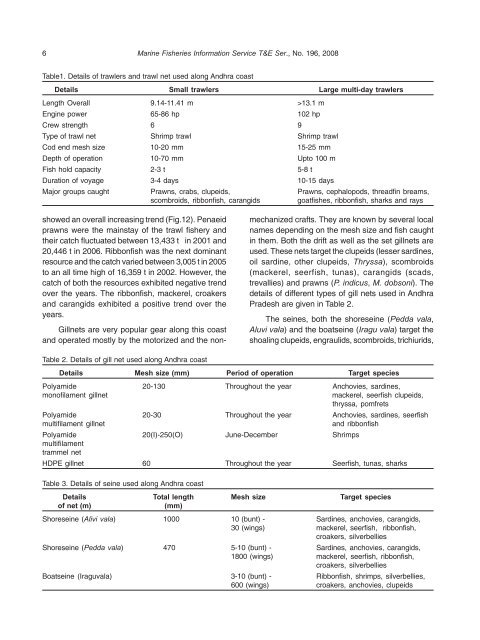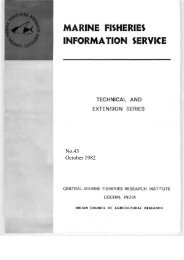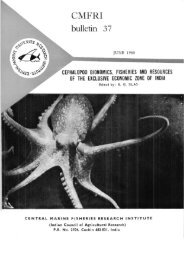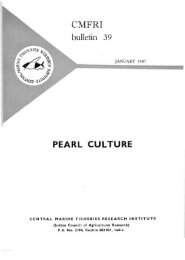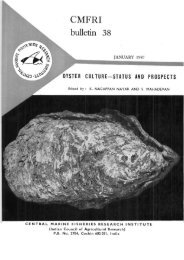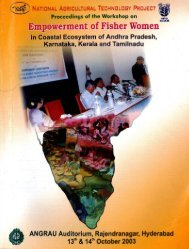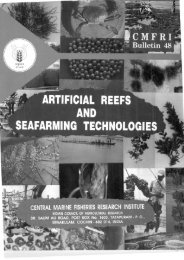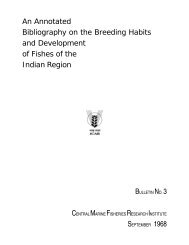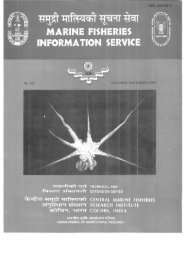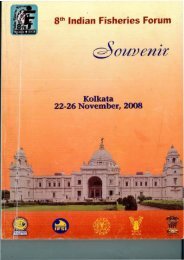Marine Fisheries Information Service - Eprints@CMFRI - Central ...
Marine Fisheries Information Service - Eprints@CMFRI - Central ...
Marine Fisheries Information Service - Eprints@CMFRI - Central ...
Create successful ePaper yourself
Turn your PDF publications into a flip-book with our unique Google optimized e-Paper software.
6 <strong>Marine</strong> <strong>Fisheries</strong> <strong>Information</strong> <strong>Service</strong> T&E Ser., No. 196, 2008<br />
Table1. Details of trawlers and trawl net used along Andhra coast<br />
Details Small trawlers Large multi-day trawlers<br />
Length Overall 9.14-11.41 m >13.1 m<br />
Engine power 65-86 hp 102 hp<br />
Crew strength 6 9<br />
Type of trawl net Shrimp trawl Shrimp trawl<br />
Cod end mesh size 10-20 mm 15-25 mm<br />
Depth of operation 10-70 mm Upto 100 m<br />
Fish hold capacity 2-3 t 5-8 t<br />
Duration of voyage 3-4 days 10-15 days<br />
Major groups caught Prawns, crabs, clupeids, Prawns, cephalopods, threadfin breams,<br />
scombroids, ribbonfish, carangids<br />
goatfishes, ribbonfish, sharks and rays<br />
showed an overall increasing trend (Fig.12). Penaeid<br />
prawns were the mainstay of the trawl fishery and<br />
their catch fluctuated between 13,433 t in 2001 and<br />
20,446 t in 2006. Ribbonfish was the next dominant<br />
resource and the catch varied between 3,005 t in 2005<br />
to an all time high of 16,359 t in 2002. However, the<br />
catch of both the resources exhibited negative trend<br />
over the years. The ribbonfish, mackerel, croakers<br />
and carangids exhibited a positive trend over the<br />
years.<br />
Gillnets are very popular gear along this coast<br />
and operated mostly by the motorized and the nonmechanized<br />
crafts. They are known by several local<br />
names depending on the mesh size and fish caught<br />
in them. Both the drift as well as the set gillnets are<br />
used. These nets target the clupeids (lesser sardines,<br />
oil sardine, other clupeids, Thryssa), scombroids<br />
(mackerel, seerfish, tunas), carangids (scads,<br />
trevallies) and prawns (P. indicus, M. dobsoni). The<br />
details of different types of gill nets used in Andhra<br />
Pradesh are given in Table 2.<br />
The seines, both the shoreseine (Pedda vala,<br />
Aluvi vala) and the boatseine (Iragu vala) target the<br />
shoaling clupeids, engraulids, scombroids, trichiurids,<br />
Table 2. Details of gill net used along Andhra coast<br />
Details Mesh size (mm) Period of operation Target species<br />
Polyamide 20-130 Throughout the year Anchovies, sardines,<br />
monofilament gillnet<br />
mackerel, seerfish clupeids,<br />
thryssa, pomfrets<br />
Polyamide 20-30 Throughout the year Anchovies, sardines, seerfish<br />
multifilament gillnet<br />
and ribbonfish<br />
Polyamide 20(I)-250(O) June-December Shrimps<br />
multifilament<br />
trammel net<br />
HDPE gillnet 60 Throughout the year Seerfish, tunas, sharks<br />
Table 3. Details of seine used along Andhra coast<br />
Details Total length Mesh size Target species<br />
of net (m)<br />
(mm)<br />
Shoreseine (Alivi vala) 1000 10 (bunt) - Sardines, anchovies, carangids,<br />
30 (wings) mackerel, seerfish, ribbonfish,<br />
croakers, silverbellies<br />
Shoreseine (Pedda vala) 470 5-10 (bunt) - Sardines, anchovies, carangids,<br />
1800 (wings) mackerel, seerfish, ribbonfish,<br />
croakers, silverbellies<br />
Boatseine (Iraguvala) 3-10 (bunt) - Ribbonfish, shrimps, silverbellies,<br />
600 (wings) croakers, anchovies, clupeids


